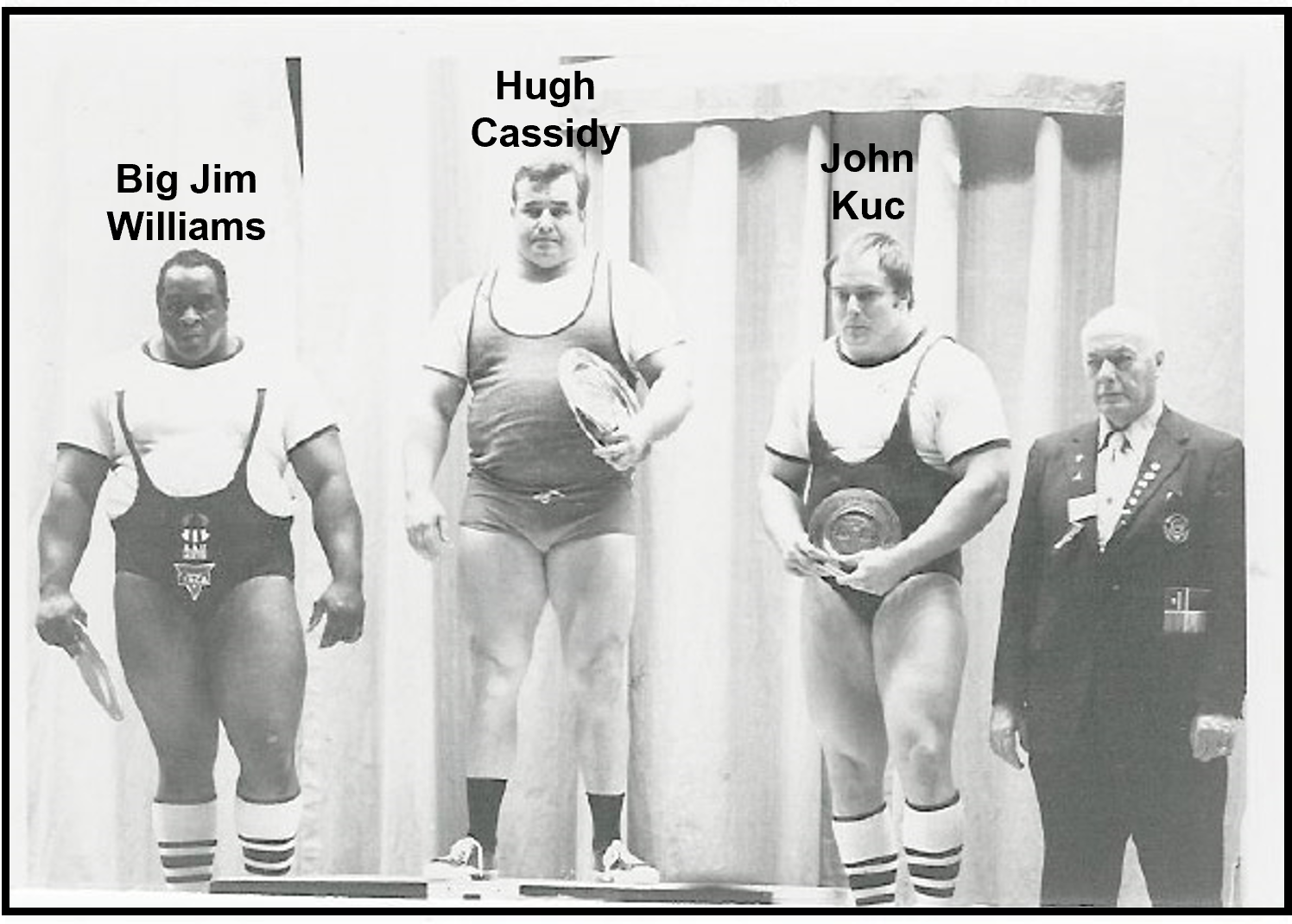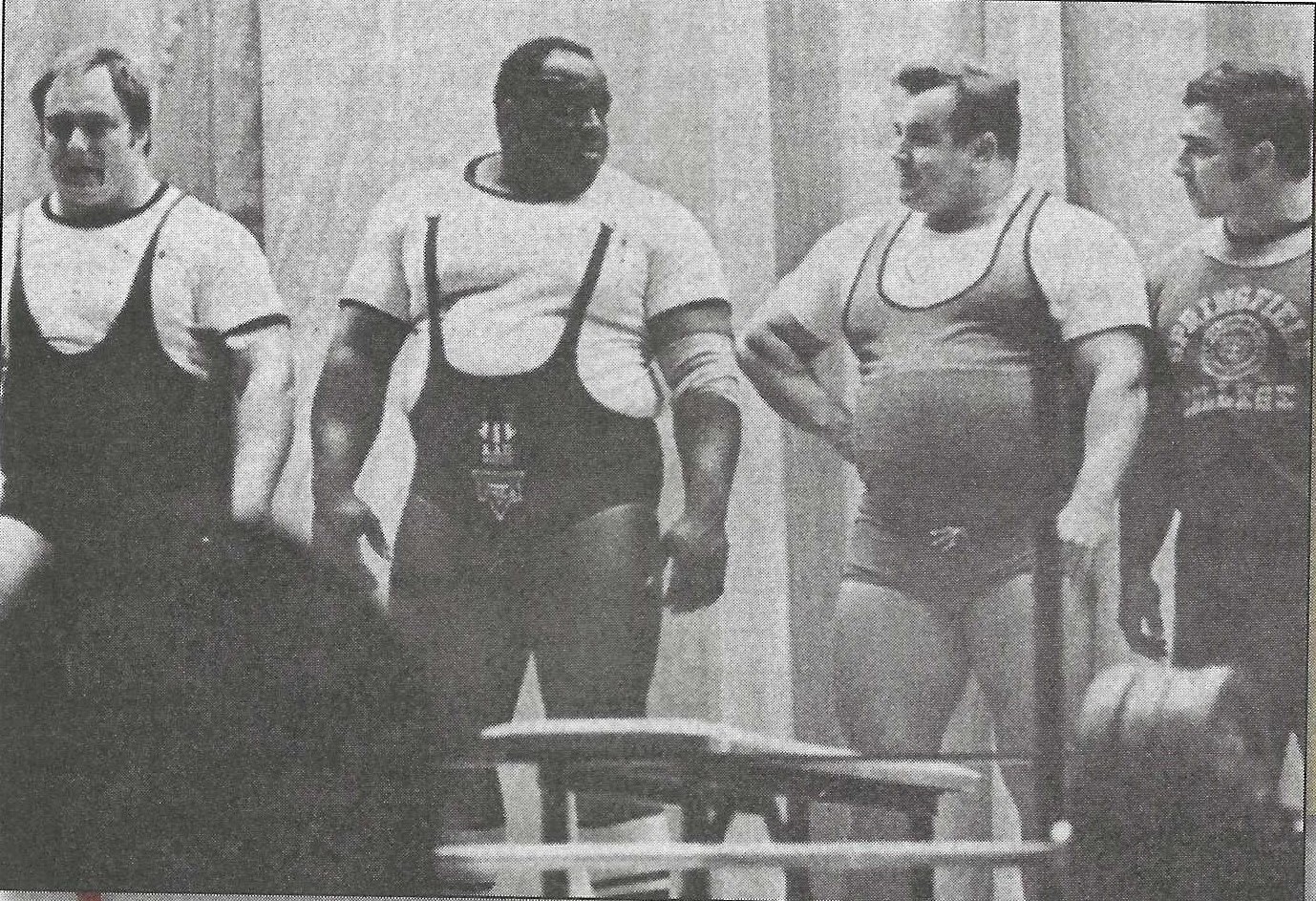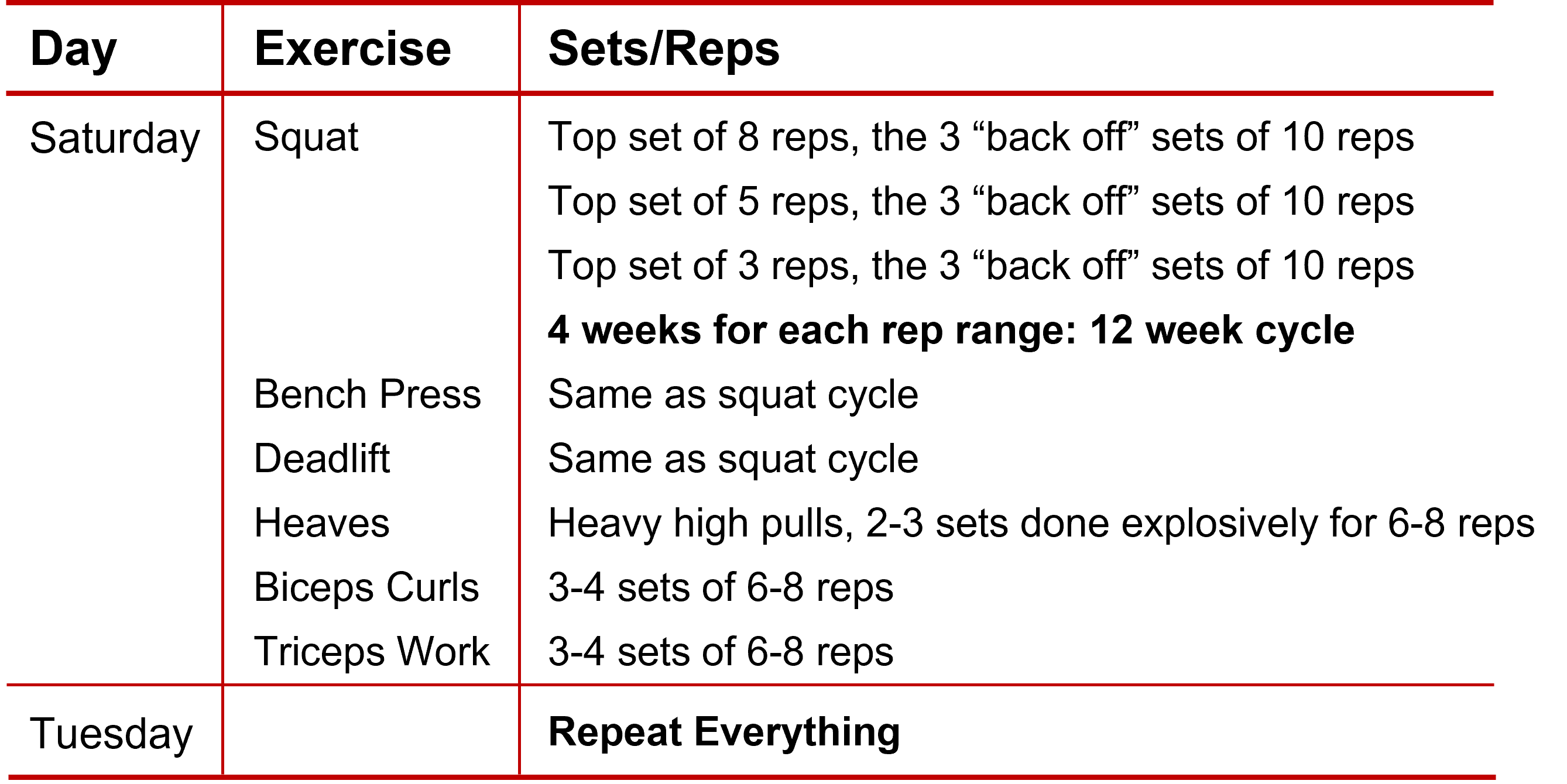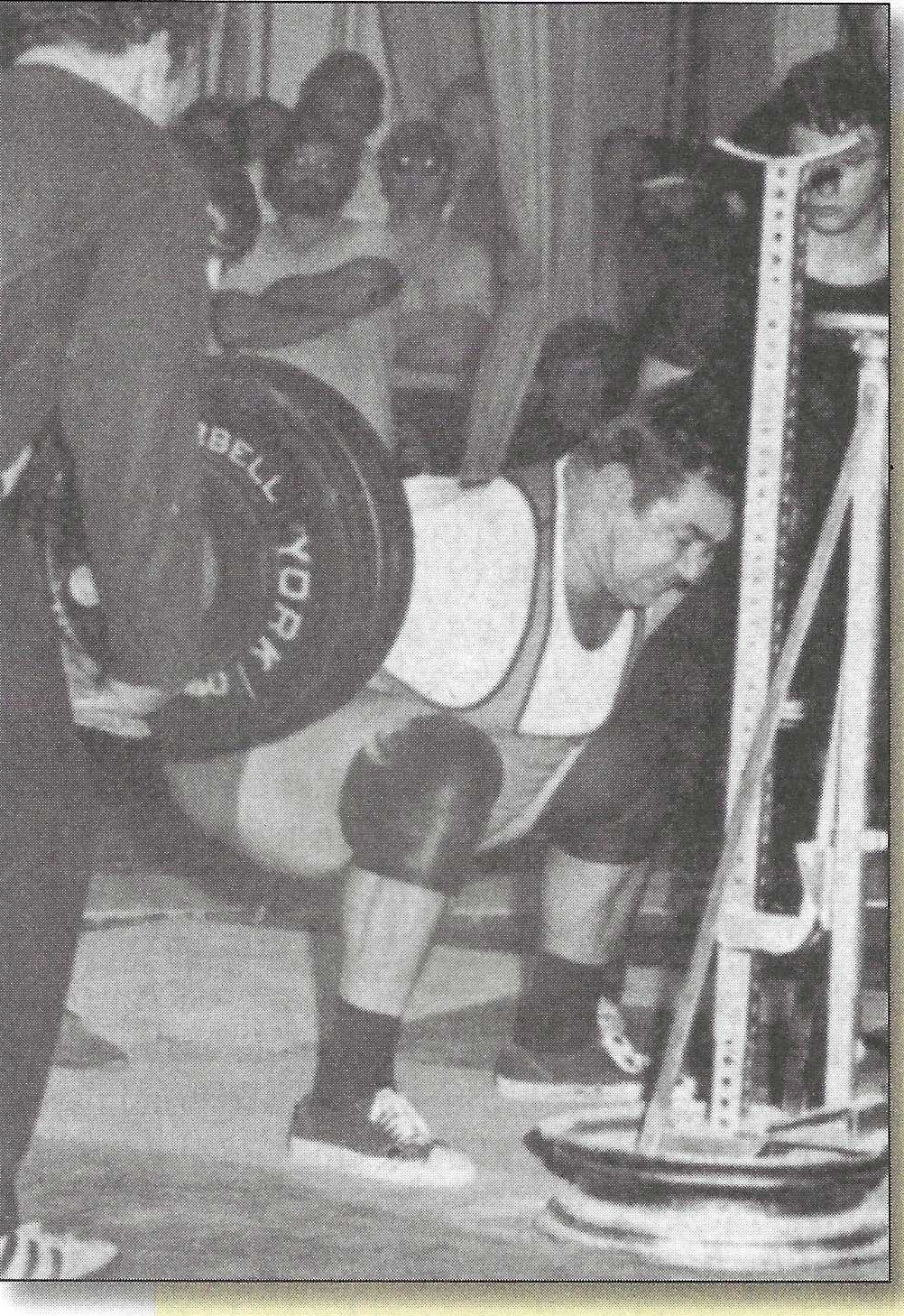
Cassidy pulls 790 to win the world championships in 1971. Tough freaking competition: Jim Williams and John Kuc! Hugh pushed his weight to 292 using sumo wrestler eating tactics and a bare bones approach to lifting that was rooted in intense work done in relatively infrequent sessions. We trained as little as a twice a week under his tutelage - but oh were those sessions murderous! We needed 3-4 days of heavy eating and complete rest just to be able to walk normally.
Hugh pushed his bodyweight ever upward in order to keep the progress ball rolling. As a super heavyweight if he became stuck in the bench press at say 505x5 weighing 267, he knew that by pushing his weight to 277, 525x5 would go. "Eat your way through sticking points!" he used to say. I trained with Marshall Peck in Hugh's Fred Munster-like basement for years.
The first words Hugh Cassidy every spoke to me were, "Hey Kid! I dig your squat style!" I was backstage at the first ever DCAAU Powerlifting Championships in 1968. I was 17 and taking my last warm-up. I knew Hugh was a pretty big deal in the then embryonic world of powerlifting. I ignominiously went on to bomb out, missing three squats with 500. I weighed 193 and insisted on starting with 500, though my best at the time was 510. I got bent forward and missed the lift on my opener. It felt heavy as hell and in those days if you missed and no one else took the same weight, you had three minutes before you had to lift it again: bip, bang, boom! Three strikes and Marty was out of the competition.
The next time I saw Hugh was on a road trip to the inaugural National Powerlifting Championships held in York, PA in September of 1968. The trip was put together by a mutual friend, the gentlemanly Glenn Middleton. Glenn was an engineer with a huge international conglomerate and a strength aficionado who'd trained with the Schemansky brothers in Detroit. He would act as our tour director for road trips to York.
Glenn was a great lifting referee, tough and able. He was super strict and the lifters took to calling him "Dr. Red Light." He took a shine to me and always included me in the road trips he would organize to York for the Olympic and power competitions. Hugh once said of Glenn, "The guy is brilliant; so well rounded. He'll custom load bird shot, shoot a pheasant or brace a quail, then construct the perfect gourmet meal, cooking the birds to perfection.
Two carloads of local lifters left for York for the first ever National Powerlifiting Championships; the York Picnic would be held the next day in a local park. At the competition I at next to Hugh; he was a 242 pound lifter looking to move up to the heavyweight class. I was impressed with is methodical approach to eating. He was determined to push his weight to 300 and see what weights he would be capable of lifting. He carried a giant cooler into the auditorium. In it were a dozen sandwiches and two half gallons of milk. We sat and watched the lifting from great seats down front. Hugh would graze and munch periodically eating a sandwich, washing it down with milk. We saw Peanuts West miss his squats and bomb out. Later, a triumphant George Frenn lifted and won at 242. During the trophy presentation Frenn physically wrested the microphone from MC Morris Weisbrott and proceeded to call forth a massively embarrassed Peanut from backstage. Frenn then launched into a fifteen minute Castro-like Peanut West Soliloquy that no one in attendance will ever forget. At the time the number one hit on the radio was "Ode to Billy Joe." After Frenn' monologue, Hugh deadpanned, "Ode to Peanuts West." I was not to see Hugh again until 1979.
Eat Your Way Through Sticking Points
Cassidy kept eating his sandwiches and drinking milk by the gallon. His sumo wrestler approach worked: at a height of 5'11" he eventually pushed his bodyweight to 290+ pounds and shocked the powerlifting world by upsetting both Big Jim Williams and John Kuc at the first World Powerlifting Championships in 1971. Hugh squatted 800, bench pressed 570 and deadlifted 790. He lifted equipment-less: no knee wraps, no supportive gear of any type, not even a lifting belt. He injured a knee the following year and retired from powerlifting.

Being a smart man, rather than stay gargantuan, as so many lifters do, Cassidy reduced from 295 to 195 and entered a few bodybuilding competitions. He continued to train on his little farmette located off Highbridge road in Bowie, MD. Hugh had many interests; he taught school and had a living wife and four kids all within a few years of each other. He left powerlifting and never looked back. In the mid-seventies a young, promising lifter named Mark Dimiduk sought out Hugh and began training under Hugh's tutelage. Dimiduk eventually became a lifting terminator, winning the Junior Nationals, (beating Danny Wohleber) and then winning the National and World Championships. Mark began training on his own.
The hard lessons "The Duck" learned under Hugh formed the foundation for a fabulous powerlifting career. Mark squatted and deadlifted 800 and bench pressed 500 while weight a lean and shredded 219. In 1978 I decided to begin weight training after a six year hiatus. During that time I had gotten into martial arts and trained at a facility with competitive fighters. I was bitten by the iron bug once again. After a year of generalized training, I saw an announcement in the "coming events" section of the Washington Post, Hugh Cassidy would be putting on a seminar in College Park. I attended and afterwards reintroduced myself. He remembered me. We hit it off and he invited me to training at his home gym. I stayed for many years and made fabulous progress.
All Aboard the Pain Train!
Hugh Cassidy's basement gym looked like something from the TV show "The Munsters." Homemade equipment (Hugh was an expert welder) was crammed and stuffed into every nook and cranny. The basement of his funky, homey, artist house had a ceiling only seven feet in height, so no standing overhead lifting was possible.
Hugh introduced me to Marshall "Doc" Peck, a semi-probaseball pitcher who began having arm problems and switched from baseball to powerlifting. Peck eventually squatted 790, benched 530 and pulled 710 weighing 218. Hugh was training with Marshall and asked if I would like to become their third training partner. I accepted immediately.
I found Cassidy a riddle wrapped in an enigma tucked inside a paradox. He was an artist of the highest order, an excellent musician who played great guitar and exceptional bass. He worked in various bands, but opted out of the night club scene on account of his acute susceptibility to cigarette smoke. Hugh was a metal sculpture artist. He started off with simple one-dimensional wall relief tubing pieces, worked through an industrial glass tabletop phase before developing refined welding techniques used on his three-dimensional nightmare creatures. Some of his devils and demons were so liefelike that they appeared ready to spring to life. As the ever eloquent Agro-American Peck once quipped, "Freaking Hugh's monsters give me the hee-bee jee-bees!"
Cassidy might be found in his ample truck garden, grafting pear branches onto apple trees, reading classical literature or welding art. He taught special needs children and had more mental horsepower and artistic creativity than any athlete ever met, before or since. He was directly responsible for starting me off on my writing career when he graciously consented to co-author some powerlifting pieces. He was tough on me and had trouble with my "bombastic" style. He was on us hard in the weight room. We trained twice a week and slammed down calories to speed recovery on the in between days. Hugh's approach could e summarized thusly: train like a psycho, eat everything in sight, rest up and grow gargantuan. For young testosterone-laden men seeking size, strength and power his minimalist approach was magical.

The introductions at the 1971 world powerlifting championships. On the left, a very young 340lb John Kuc, then Big Jim Williams, the greatest bench presser in history (700 raw) and Hugh, who is no doubt wryly saying "Take it easy on me Big Jim!" Big Jim is no doubt saying back, "Don't try and jive me HUGE." They called Hugh, "Huge." Carlton Snitken leans in on the right to hear the banter.
Lift Big, Eat Big, Rest Big, Grow Big!
We would start our Saturday enduro with squats and work up to a top set. Depending on what phase of the overall training 'cycle' we were in, the top set could be 8 reps, 5 reps or 3 reps. 8 rep sets were done for four straight weeks, starting 12 weeks prior to competing. Eight weeks out we'd shift to 5 rep sets. For the final four weeks leading up to the competition, the top sets were dropped to triples or doubles. Ditto for the all important back-off sets: these were done with lighter poundage.
Peck and I would wear knee wraps and a belt working up to the top set. Then take off the wraps and belt for the three back-off sets of 10 reps, 8 reps or 5 reps. The back-off sets were done with a considerably lighter weight than the belt/wrap top set. Pumped to the max after the squat back-offs, we would shift to bench pressing and repeat the same procedure: work up to a top set of 8, 5, or 3, then three sets of back-offs. After benching our legs and lower back were somewhat recovered, so it was on to deadlifts. Again, work up to a top set, then three sets of back-offs. Hugh would have us do stiff-leg deadlifts on the back-off sets. Then for desert 3-6 sets of arms usually super-setting curls with triceps presses or pushdowns.

For a while Hugh got on a heave kick, which was sort of a massive high pull done with a lot of weight while trying to generate momentum at the top. When he'd insert these after deadlifts we'd groan. We would repeat the whole deal 3-4 days later. It would take us hours to get through this workout. Often I'd have to lie down before I had the strength to drive home. Peck and I would stop at the 7-11, buy a half gallon of ice cold whole milk (each) to drink on the ride home. Milk never tasted as good as it did after an August training session in the dungeon with only a single plastic fan to keep us from keeling over. Hugh would tell us when we complained of tiredness to fire down more calories. "Eat your way through sticking points!" He'd say. If the poundage was feeling heavy on Saturday weighing 216 push your bodyweight to 22 by Tuesday and make those weights seem light. This was a man-killer approach: train till you begin hallucinating, eat tons of food, drink four quarts or more of milk daily then rest until the 2nd weekly slaughter fest. This approach worked wonders for aggressive young men intent on becoming massively muscled competitive powerlifters. Hugh was a 'psych up' master and could visibly manifest his internal psyche by the use of what he called "cooling breaths." He was able to make this happen at will.

hugh cassidy
I cannot explain it psychologically, but I have found that if I expel my breath in sharp gasps I get goose pimples all over my body. In this condition I lift far more in meets than in training, averaging 40 pounds above my best training effort for both the squat and deadlift.
Cassidy was one of a kind: brilliant, moody, insightful, soulful, introverted and sensitive. My time with him laid a foundation of hardcore training that has served me well ever since. Never was the adage, "hard work pays off" more apparent then in his take-no-prisoners, ultra-simplistic, Purposefully Primitive approach that he exemplified and taught. nowadays most lifters under-eat and under-training: many are vain surface skimmers with low pain tolerance and lots of self-esteem. The Old School approach of train-till-you-drop is politically incorrect and even suggesting it to the new breed is a waste of breath. I have often though that if I ever wanted to train a kid powerlifter to become a world beater, I would draft on of those X-Game skateboarders or motocross kids that do those death defying jumps. I think that powerlifters and lifters of my generation had that same crazed mindset. Nowadays fanatical types participate in other sports.

Hugh says: "My squat routines are simple and basic and use no assistance exercises; squats alone twice a week work well for me. The following is a routine I use most of the time, with the emphasis on the 3 sets of 5 reps, which I believe are the hallmark of the routine.
The multiple sets force power as well as muscle growth to take place. And as your fives go up, so of course, do you max double or triple. Thus I warm-up with 275x8, 435x5, 535x5, 625x3 then 700x2 ... (then the back-off sets) 610x5, 625x5 and 640x5. I seldom do more than eight sets of squats regardless the routine. As the meet draws near, with about six workouts to go, I continue to go up to a max double or triple. I changed the back-off sets from fives to threes ... prior to the 1971 World Championships in my last workout my back-off sets were 700x3 and 725x3. I was too tired to attempt a third one. The 800x1 (photo above) made at the World Championships was easy - I wish I had taken more that day."
Check out the links below for profiles on other remarkable men I have met in my almost 60 years of training. Each have influenced me in different ways over the course of my strength career.
Learn more about our training philosophy check out our Progressive Resistance Resource Page. Join the community sign up below to our newsletter and receive our FREE Planning and Periodization Guide.
Want the inside training scoop?
Join The Community
Our email content is full of value, void of hype, never pushy, and always free. As a BONUS you will receive our FREE planning & periodization template to help you with your training goals.



